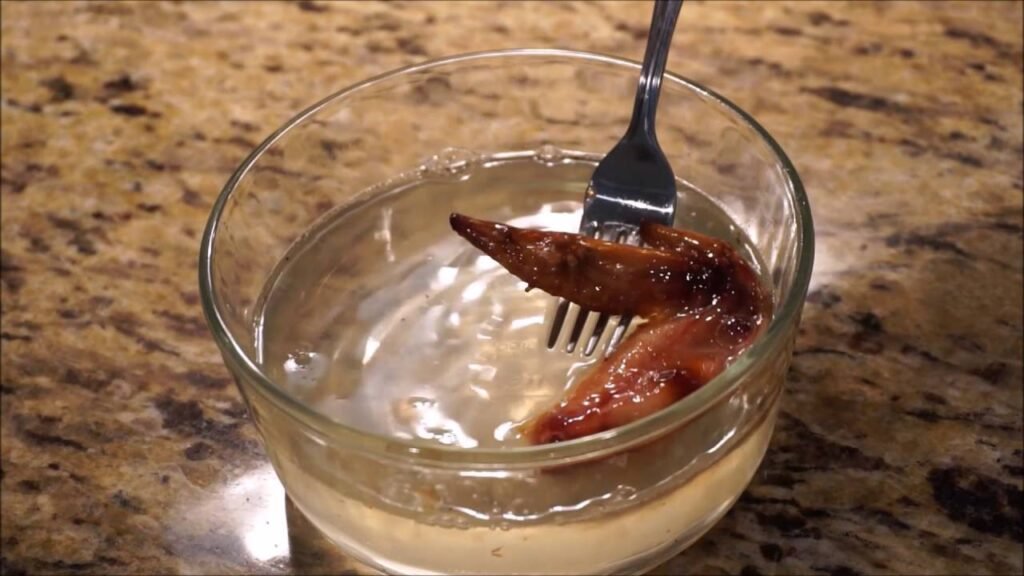Potassium Hydroxide Dissolves Chicken To The Bone
4 min read
I use caustic potassium lye, also known as caustic potash to dissolve chicken flesh. First I don the appropriate protective gear to deal with such a caustic solution. Then I pour out about 200 g of potassium hydroxide and add it to about 1.5 cups of water As I am adding the KOH the water instantly begins to boil as the KOH dissolving in water is highly exothermic. After I put in all of the KOH I measure the temperature of the water to be very near boiling, about 205°F.
I then add the chicken wing into the caustic solution. I explain that the hydroxide ions will essentially turn the chicken into soap. This works by breaking down the fat molecules in the cell walls and turning them into glycerol and soap molecules. Watch the fat and meat slowly turn to gel as the potassium hydroxide reacts with the flesh.
Eventually the entire chicken wing dissolves into a gelatinous mass. In the end I show the final product that used to be meat is a transparent soft gel.
I do make a mistake some have pointed out by saying the cells of the chicken flesh have cell walls. Really I just mean the lipid bilayer (cell membrane). Not a true cell wall like in plant cells.
Here is some more info on potassium hydroxide from Wikepedia:
Along with sodium hydroxide (NaOH), this colorless solid is a prototypical strong base. It has many industrial and niche applications, most of which exploit its corrosive nature and its reactivity toward acids. An estimated 700,000 to 800,000 tonnes were produced in 2005. Approximately 100 times more NaOH than KOH is produced annually.[9] KOH is noteworthy as the precursor to most soft and liquid soaps as well as numerous potassium-containing chemicals.
Potassium hydroxide can be found in pure form by reacting sodium hydroxide with impure potassium. It is usually sold as translucent pellets, which will become tacky in air because KOH is hygroscopic. Consequently, KOH typically contains varying amounts of water (as well as carbonates, see below). Its dissolution in water is strongly exothermic. Concentrated aqueous solutions are sometimes called potassium lyes. Even at high temperatures, solid KOH does not dehydrate readily.[10]
Potassium hydroxide solutions with concentrations of approximately 0.5 to 2.0% are irritating when coming into contact with the skin, while concentrations higher than 2% are corrosive.
Historically KOH was made by adding potassium carbonate (potash) to a strong solution of calcium hydroxide (slaked lime), leading to a metathesis reaction which caused calcium carbonate to precipitate, leaving potassium hydroxide in solution:
Ca(OH)2 + K2CO3 → CaCO3 + 2 KOH
Filtering off the precipitated calcium carbonate and boiling down the solution gives potassium hydroxide (“calcinated or caustic potash”). It was the most important method of producing potassium hydroxide until the late 19th century, when it was largely replaced by the current method of electrolysis of potassium chloride solutions.[9] The method is analogous to the manufacture of sodium hydroxide (see chloralkali process):
2 KCl + 2 H2O → 2 KOH + Cl2 + H2
Hydrogen gas forms as a by-product on the cathode; concurrently, an anodic oxidation of the chloride ion takes place, forming chlorine gas as a by-product. Separation of the anodic and cathodic spaces in the electrolysis cell is essential for this process.
USES KOH and NaOH can be used interchangeably for a number of applications, although in industry, NaOH is preferred because of its lower cost.
ike sodium hydroxide, potassium hydroxide attracts numerous specialized applications, virtually all of which rely on its properties as a strong chemical base with its consequent ability to degrade many materials. For example, in a process commonly referred to as “chemical cremation” or “resomation,” potassium hydroxide hastens the decomposition of soft tissues, both animal and human, to leave behind only the bones and other hard tissues.[19] Entomologists wishing to study the fine structure of insect anatomy may use a 10% aqueous solution of KOH to apply this process.[20]
In chemical synthesis, the choice between the use of KOH and the use of sodium hydroxide, NaOH, is guided by the solubility of the resulting salt.
The corrosive properties of potassium hydroxide make it a useful ingredient in agents and preparations that clean and disinfect surfaces and materials that can themselves resist corrosion by KOH.[21]
KOH is also used for semiconductor chip fabrication. Potassium hydroxide is often the main active ingredient in chemical “cuticle removers” used in manicure treatments.
Because aggressive bases like KOH damage the cuticle of the hair shaft, potassium hydroxide is used to chemically assist the removal of hair from animal hides. The hides are soaked for several hours in a solution of KOH and water to prepare them for the unhairing stage of the tanning process. This same effect is also used to weaken human hair in preparation for shaving.




